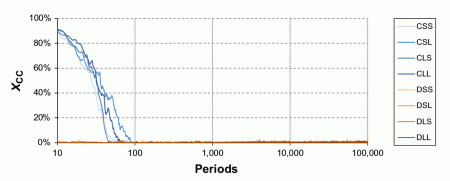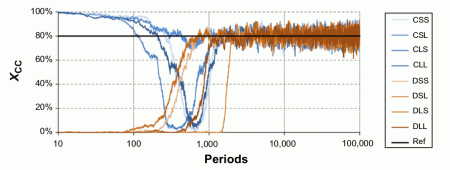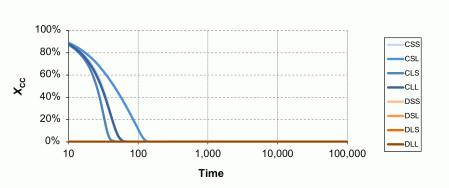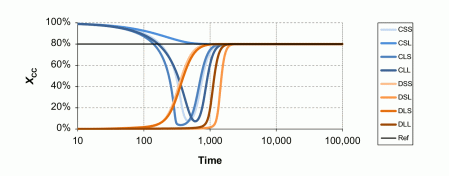(Versión en español aquí)
In previous posts of this blog (here, and here) we have already discussed the effect of reputation and dynamic links on cooperation. Recently, we have performed a series of experiments to explore the effect of information, together with the possibility of changing partners, on the cooperative behavior. In this post, I report on a theoretical study: Leave and let leave: A sufficient condition to explain the evolutionary emergence of cooperation, by Luis Izquierdo, Segismundo Izquierdo and Fernando Vega-Redondo, Journal of Economic Dynamics and Control , 4691–113 (2014). In this study, the authors isolate the effect of conditional dissociation (that is, the possibility of breaking a partnership based on the partner’s behavior) by proposing a model that they solve both analytically, through a mean-field approximation, and numerically. They show that the conditional dissociation mechanism is enough to sustain a significant level of cooperation if the expected lifetime of individuals is sufficiently long.
Izquierdo et al. took as a starting point a previous model studied by Fujiwara-Greve and Okuno-Fujiwara. In that previous study, Fujiwara and Okuno considered an infinitely large population of agents playing a repeated Prisoner’s Dilemma Game and having the choice of changing their partner. The central question that Izquierdo et al. addressed is if the option to leave a partner in response to his action can just by itself provide an evolutionary basis for the rise of cooperation. To address this issue, the authors imposed restrictions on the strategy space, focusing on the simplest strategy space that allows for conditional dissociation, i.e., one where individuals are either cooperators or defectors and their decision comes down to maintaining the current partner or not, based on their partner’s behavior. This very simplistic setting allows, on one hand, to isolate the effect of conditional dissociation. On the other hand, the main merit of this simplification is that it allows to analyze (through a mean field dynamics approach) the dynamics of the model.
Specifying, the model consists of a finite population of individuals who interact in pairs through a repeated Prisoner’s Dilemma. Their strategies have three components, the first component (C or D) determines whether the individual is a cooperator or a defector in all of her interactions, the second component (L or S) specifies whether she leaves or stays with her current partner after the latter has cooperated, while the third component (L or S) specifies an analogous choice after her current partner has defected. In consequence, there are eight possible strategies. No mixed strategies are considered. Initially, the individuals are randomly matched in pairs, and the subsequent dynamics is simple: If an individual chooses to leave her partner, both individuals move to a pool of singles. In addition, individuals have associated an expected lifetime: when an individual dies, her partner enters the pool of singles, and the dead individual is immediately replaced by a new entrant (single) who copies her strategy from one of the individuals who played the game in the current period, with a probability proportional to the individual’s payoff in the current period (there is a probability μ of mutation for every entrant, in that case the entrant takes a random strategy). Finally, single individuals are randomly matched in pairs for the next period.
The authors used three different approaches to solve the model. First, they performed some computer simulations to explore the behavior of the system, and secondly, they carried out a stability analysis that provides Nash equilibria under some restrictions. Finally, they conducted a mean field analysis that captures the dynamics of the finite-size counterpart. Regarding computer simulations, the next figure shows the evolution of the level of cooperation Xcc for 8 different realizations, each one starting with the whole population sharing the same strategy (CSS, CSL, …, DLL):

 As the top panel shows, for short expected lifetimes (here f=5 periods), the system evolves towards a non-cooperative regime, while, as the bottom panel shows, for long expected lifetimes (here f=50 periods) it evolves towards a high-cooperation regime. These results illustrate that the system presents very high levels of cooperation for long enough values of individuals’ expected lifetime.
As the top panel shows, for short expected lifetimes (here f=5 periods), the system evolves towards a non-cooperative regime, while, as the bottom panel shows, for long expected lifetimes (here f=50 periods) it evolves towards a high-cooperation regime. These results illustrate that the system presents very high levels of cooperation for long enough values of individuals’ expected lifetime.
From now on, the authors consider the case where the population is very large. For the static analysis, based on the previous work of Fujiwara and Okuno, the authors look for the stationary states under the assumption that the mutation rate μ is infinitesimally small. They find two Nash distributions of strategies, namely, while for low values of the expected lifetime only defection is stable, for large values of the expected lifetime, in addition to the previous equilibrium, a set of partially cooperative distributions is stable too. The critical value of the expected life is determined by the pay-off matrix.
Finally, and this is the most interesting part of the study, the authors explore a set of mean field dynamics equations (under certain new assumptions) which happens to be a very good approximation of the stochastic evolution of the model. The next figure shows the evolution of the level of cooperation Xcc for 8 different realizations, whose initial strategies distributions match those of the previous figure, that is, each realization starting with the whole population sharing the same strategy. As above, the top panel stands for short expected lifetimes (f=5 periods), while the bottom panel stands for long expected lifetimes (f=50 periods):

 By comparing the previous figure and this one, one sees that the mean dynamics approach matches very well the simulation results, according to the authors’ statement: this illustrates that, the (deterministic) mean approach represents a useful tool to study the (stochastic) behavior generated by the original evolutionary process when the population is large.
By comparing the previous figure and this one, one sees that the mean dynamics approach matches very well the simulation results, according to the authors’ statement: this illustrates that, the (deterministic) mean approach represents a useful tool to study the (stochastic) behavior generated by the original evolutionary process when the population is large.

Pingback: Aislando el efecto de la disociación condicional en la emergencia de la cooperación. | Nectunt Bitacora